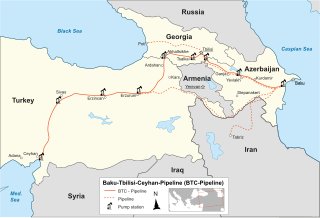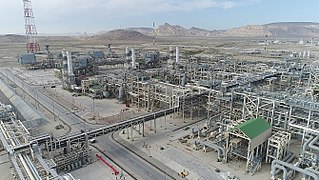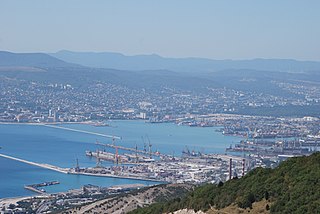
The Baku–Tbilisi–Ceyhan (BTC) pipeline is a 1,768 kilometres (1,099 mi) long crude oil pipeline from the Azeri–Chirag–Gunashli oil field in the Caspian Sea to the Mediterranean Sea. It connects Baku, the capital of Azerbaijan and Ceyhan, a port on the south-eastern Mediterranean coast of Turkey, via Tbilisi, the capital of Georgia. It is the second-longest oil pipeline in the former Soviet Union, after the Druzhba pipeline. The first oil that was pumped from the Baku end of the pipeline reached Ceyhan on 28 May 2006.
Tengiz field is an oil field located in Zhylyoi District, Atyrau Region, northwestern Kazakhstan.
Karachaganak Field is a gas condensate field about 23 kilometres (14 mi) east of Aksay (Ақсай) in northwest Kazakhstan. It was once a massive Permian and Carboniferous reef complex covering an area 30 by 15 square kilometres. At its largest point, the reservoir contains a gas column 1,450 metres (4,760 ft) deep with a 200 metres (660 ft) deep oil rim below it. It is estimated to contain 1.2 trillion cubic metres of gas and one billion tonnes of liquid condensate and crude oil. Discovered in 1979, it began production under Karachaganakgazprom, a subsidiary of Gazprom. In 1992, AGIP and British Gas were awarded sole negotiating rights, forming a partnership company. In 1997, Texaco and Lukoil signed a 40-year production sharing agreement with the original two companies and the Kazakhstan government to develop the field for world markets. The agreement was turned under a partnership company known as Karachaganak Petroleum Operating (KPO) where Royal Dutch Shell and ENI are joint operators with a 29.25% stake each in the company, and with Chevron and Lukoil owning 18% and 13.5% respectively. In September 2009 the KPO filed an arbitration case against Kazakhstan. The Republic of Kazakhstan appointed Maksat Idenov to lead the negotiations, after which the arbitration was suspended towards an amicable settlement of the dispute and KazMunayGas engaged in entrance into the project in 2010. Under the terms of an agreement reached on December 14, 2011, the Republic of Kazakhstan has acquired through KazMunayGas a 10% stake for $2 billion cash and $1 billion non-cash consideration.
Kashagan Field is an offshore oil field in Kazakhstan's zone of the Caspian Sea. The field, discovered in 2000, is located in the northern part of the Caspian Sea close to Atyrau and is considered the world's largest discovery in the last 30 years, combined with the Tengiz Field. When discovered, it was the second largest oil field in the world.

The Ünye–Ceyhan pipeline, commonly known with its former name, the Samsun–Ceyhan pipeline, was a planned crude oil pipeline traversing Turkey from the Black Sea to the Mediterranean oil terminal in Ceyhan. The aim of the project was to provide an alternative route for Russian and Kazakhstani oil and to ease the traffic burden in the Bosporus and the Dardanelles. The project was halted in 2010. This was confirmed again in 2013.
Azeri–Chirag–Gunashli or Azeri–Chirag–Deepwater Gunashli is a complex of oil fields in the Caspian Sea, about 120 kilometres (75 mi) off the coast of Azerbaijan. It consists of the Azeri and Chirag oil fields, and the deepwater portion of the Gunashli oil field. An overall estimate of the area of the development is 432.4 square kilometres (167.0 sq mi). It is developed by the Azerbaijan International Operating Company, a consortium of international oil companies, and operated by BP on behalf of the consortium. The ACG fields have estimated recoverable reserves of about 5 to 6 billion barrels of petroleum. Peak oil production of 835,000 barrels per day (132,800 m3/d) was reached in 2010, however by the first quarter of 2022 production had declined to 434,000 barrels per day (69,000 m3/d), or about one-half of peak value. As of 2021, ACG oil accounted for 95% of all Azerbaijani oil exports.
The Trans-Caspian Oil Transport System is a proposed project to transport oil through the Caspian Sea from Kazakhstani Caspian oilfields to Baku in Azerbaijan for the further transportation to the Mediterranean or Black Sea coast. The main options under consideration are an offshore oil pipeline from Kazakhstan to Azerbaijan, and construction of oil terminals and oil tankers fleet. A strong push for the project has been from the partners of the Kashagan oilfield project and in particular Total who has a share in both the field and the BTC pipeline. They have estimated that such a project would cost roughly US$4 billion. The project also faces opposition from Iran and Russia, both alternative avenues for Kazakhstan's oil and gas who would likely object to competing pipelines being built.
The Kazakhstan–China oil pipeline is China's first direct oil import pipeline allowing oil import from Central Asia. It runs from Kazakhstan's Caspian shore to Xinjiang in China. The pipeline is owned by the China National Petroleum Corporation and the Kazakh oil company KazMunayGas.
The Eastern Siberia–Pacific Ocean oil pipeline is a pipeline system for exporting Russian crude oil to the Asia-Pacific markets. The pipeline is built and operated by Russian pipeline company Transneft.

The Petroleum or oil industry in Russia is one of the largest in the world. Russia has the largest reserves and was the largest exporter of natural gas. It has the sixth largest oil reserves, and is one of the largest producers of oil. It is the fourth largest energy user.
Energy in Kazakhstan describes energy and electricity production, consumption and import in Kazakhstan and the politics of Kazakhstan related to energy.

The Sangachal Terminal is an industrial complex consisting of a natural gas processing plant and oil production plant, located on the coast of the Caspian Sea 45 kilometres (28 mi) south of Baku, Azerbaijan.

The Baku–Supsa Pipeline is an 833-kilometre (518 mi) long oil pipeline, which runs from the Sangachal Terminal near Baku to the Supsa terminal in Georgia. It transports oil from the Azeri-Chirag-Guneshli field. The pipeline is operated by BP.

The Baku–Novorossiysk pipeline is an 1,330-kilometre (830 mi) long oil pipeline, which runs from the Sangachal Terminal near Baku to the Novorossiysk terminal at the Black Sea coast in Russia. The Azerbaijani section of the pipeline is operated by the State Oil Company of Azerbaijan Republic (SOCAR) and the Russian section is operated by Transneft.
The Baku–Batumi pipeline is the name given to several pipelines and pipeline projects to transport kerosene and crude oil from the Caspian region to the Georgian Batumi oil terminal at the Black Sea. When first constructed in 1906, it was the world's longest kerosene pipeline.
Sources include: Dow Jones (DJ), New York Times (NYT), Wall Street Journal (WSJ), and the Washington Post (WP).
The Vankor Field is an oil and gas field in Russia, located 130 kilometres (81 mi) west of Igarka in the Turukhansk District of Krasnoyarsk Krai in Eastern Siberia, close to the border with Yamalo-Nenets Autonomous Okrug. Its estimated reserves are 520 million metric tons of oil and 95 billion cubic meters of natural gas. Production was launched in August, 2009. The field is operated by Russian national oil company Rosneft through its subsidiary Vankorneft.

Novorossiysk Sea Port is one of the largest ports in the Black Sea basin and the largest in Krasnodar Krai. At 8.3 km, the NSP berthing line is the longest among all the ports of Russia. The port is located on the Northeast coast of the Black Sea, in the Tsemes Bay. The bay is ice-free and open for navigation all year round. However, in winter the navigation occasionally stops due to the hazardous northeastern bora wind. The Tsemes Bay allows deep-draft vessels up to 19 m, and the inner harbour up to 12.5 m. The liquid bulk terminals depth range from 8.4 to 15.6 m, suitable for tankers with a deadweight of up to 250,000 tons, like Suezmax-class vessels.







